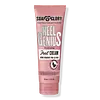What's inside
What's inside
 Key Ingredients
Key Ingredients

 Benefits
Benefits

 Concerns
Concerns

 Ingredients Side-by-side
Ingredients Side-by-side

Water
Skin ConditioningGlycerin
HumectantCetearyl Alcohol
EmollientIsononyl Isononanoate
EmollientCetyl Alcohol
EmollientUrea
BufferingPhenoxyethanol
PreservativeParfum
MaskingMacadamia Integrifolia Seed Oil
Skin ConditioningMenthyl Lactate
MaskingDisodium EDTA
Oleic/Linoleic/Linolenic Polyglycerides
EmollientMethylparaben
PreservativeAcrylates/C10-30 Alkyl Acrylate Crosspolymer
Emulsion StabilisingVaccinium Myrtillus Fruit/Leaf Extract
AstringentPropylparaben
PreservativeDipropylene Glycol
HumectantSodium Cetearyl Sulfate
CleansingSodium Lauryl Sulfate
CleansingAllantoin
Skin ConditioningMenthol
MaskingSaccharum Officinarum Extract
MoisturisingSodium Hydroxide
BufferingBenzyl Salicylate
PerfumingLinalool
PerfumingHexyl Cinnamal
PerfumingCitrus Aurantium Dulcis Fruit Extract
MaskingCitrus Limon Fruit Extract
MaskingLimonene
PerfumingAcer Saccharum Extract
Skin ConditioningPolyoxymethylene Urea
Geraniol
PerfumingDisodium Phosphate
BufferingDipotassium Phosphate
BufferingCI 42090
Cosmetic ColorantCI 19140
Cosmetic ColorantWater, Glycerin, Cetearyl Alcohol, Isononyl Isononanoate, Cetyl Alcohol, Urea, Phenoxyethanol, Parfum, Macadamia Integrifolia Seed Oil, Menthyl Lactate, Disodium EDTA, Oleic/Linoleic/Linolenic Polyglycerides, Methylparaben, Acrylates/C10-30 Alkyl Acrylate Crosspolymer, Vaccinium Myrtillus Fruit/Leaf Extract, Propylparaben, Dipropylene Glycol, Sodium Cetearyl Sulfate, Sodium Lauryl Sulfate, Allantoin, Menthol, Saccharum Officinarum Extract, Sodium Hydroxide, Benzyl Salicylate, Linalool, Hexyl Cinnamal, Citrus Aurantium Dulcis Fruit Extract, Citrus Limon Fruit Extract, Limonene, Acer Saccharum Extract, Polyoxymethylene Urea, Geraniol, Disodium Phosphate, Dipotassium Phosphate, CI 42090, CI 19140
Alternatives
Ingredients Explained
These ingredients are found in both products.
Ingredients higher up in an ingredient list are typically present in a larger amount.
Glycerin is already naturally found in your skin. It helps moisturize and protect your skin.
A study from 2016 found glycerin to be more effective as a humectant than AHAs and hyaluronic acid.
As a humectant, it helps the skin stay hydrated by pulling moisture to your skin. The low molecular weight of glycerin allows it to pull moisture into the deeper layers of your skin.
Hydrated skin improves your skin barrier; Your skin barrier helps protect against irritants and bacteria.
Glycerin has also been found to have antimicrobial and antiviral properties. Due to these properties, glycerin is often used in wound and burn treatments.
In cosmetics, glycerin is usually derived from plants such as soybean or palm. However, it can also be sourced from animals, such as tallow or animal fat.
This ingredient is organic, colorless, odorless, and non-toxic.
Glycerin is the name for this ingredient in American English. British English uses Glycerol/Glycerine.
Learn more about GlycerinLimonene is a fragrance that adds scent and taste to a formulation.
It's found in the peel oil of citrus fruits and other plants such as lavender and eucalyptus. The scent of limonene is generally described as "sweet citrus".
Limonene acts as an antioxidant, meaning it helps neutralize free radicals.
When exposed to air, oxidized limonene may sensitize the skin. Because of this, limonene is often avoided by people with sensitive skin.
The term 'fragrance' is not regulated in many countries. In many cases, it is up to the brand to define this term. For instance, many brands choose to label themselves as "fragrance-free" because they are not using synthetic fragrances. However, their products may still contain ingredients such as essential oils that are considered a fragrance.
Learn more about LimoneneLinalool is a fragrance and helps add scent to products. It's derived from common plants such as cinnamon, mint, citrus, and lavender.
Like Limonene, this ingredient oxidizes when exposed to air. Oxidized linalool can cause allergies and skin sensitivity.
This ingredient has a scent that is floral, spicy tropical, and citrus-like.
Learn more about LinaloolParfum is a catch-all term for an ingredient or more that is used to give a scent to products.
Also called "fragrance", this ingredient can be a blend of hundreds of chemicals or plant oils. This means every product with "fragrance" or "parfum" in the ingredients list is a different mixture.
For instance, Habanolide is a proprietary trade name for a specific aroma chemical. When used as a fragrance ingredient in cosmetics, most aroma chemicals fall under the broad labeling category of “FRAGRANCE” or “PARFUM” according to EU and US regulations.
The term 'parfum' or 'fragrance' is not regulated in many countries. In many cases, it is up to the brand to define this term.
For instance, many brands choose to label themselves as "fragrance-free" because they are not using synthetic fragrances. However, their products may still contain ingredients such as essential oils that are considered a fragrance by INCI standards.
One example is Calendula flower extract. Calendula is an essential oil that still imparts a scent or 'fragrance'.
Depending on the blend, the ingredients in the mixture can cause allergies and sensitivities on the skin. Some ingredients that are known EU allergens include linalool and citronellol.
Parfum can also be used to mask or cover an unpleasant scent.
The bottom line is: not all fragrances/parfum/ingredients are created equally. If you are worried about fragrances, we recommend taking a closer look at an ingredient. And of course, we always recommend speaking with a professional.
Learn more about Parfum